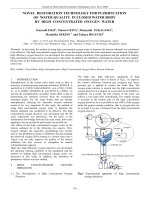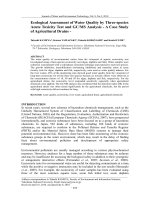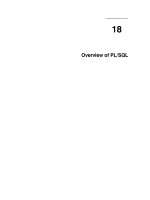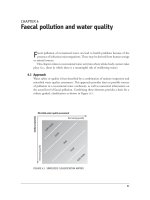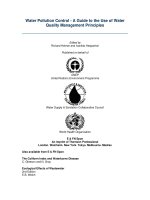Fundamental Concepts: Overview of Water Quality ppt
Bạn đang xem bản rút gọn của tài liệu. Xem và tải ngay bản đầy đủ của tài liệu tại đây (786.62 KB, 41 trang )
Fundamental Concepts:
Fundamental Concepts:
Overview of Water Quality
Overview of Water Quality
Ann Kenimer
Ann Kenimer
Texas A & M University
Texas A & M University
University Curriculum Development for
University Curriculum Development for
Decentralized Wastewater
Decentralized Wastewater
Management
Management
NDWRCDP Disclaimer
NDWRCDP Disclaimer
This work was supported by the National Decentralized Water
This work was supported by the National Decentralized Water
Resources Capacity Development Project (NDWRCDP) with
Resources Capacity Development Project (NDWRCDP) with
funding provided by the U.S. Environmental Protection Agency
funding provided by the U.S. Environmental Protection Agency
through a Cooperative Agreement (EPA No. CR827881
through a Cooperative Agreement (EPA No. CR827881
-
-
01
01
-
-
0)
0)
with Washington University in St. Louis. These materials have
with Washington University in St. Louis. These materials have
not been reviewed by the U.S. Environmental Protection
not been reviewed by the U.S. Environmental Protection
Agency. These materials have been reviewed by
Agency. These materials have been reviewed by
representatives of the NDWRCDP. The contents
representatives of the NDWRCDP. The contents
of these materials do not necessarily reflect the views and
of these materials do not necessarily reflect the views and
policies of the NDWRCDP, Washington University, or the U.S.
policies of the NDWRCDP, Washington University, or the U.S.
Environmental Protection Agency, nor does the mention of trade
Environmental Protection Agency, nor does the mention of trade
names or commercial products constitute their endorsement or
names or commercial products constitute their endorsement or
recommendation for use.
recommendation for use.
CIDWT/University Disclaimer
CIDWT/University Disclaimer
These materials are the collective effort of individuals from
These materials are the collective effort of individuals from
academic, regulatory, and private sectors of the
academic, regulatory, and private sectors of the
onsite/decentralized wastewater industry. These materials have
onsite/decentralized wastewater industry. These materials have
been peer
been peer
-
-
reviewed and represent the current state of
reviewed and represent the current state of
knowledge/science in this field. They were developed through a
knowledge/science in this field. They were developed through a
series of writing and review meetings with the goal of formulati
series of writing and review meetings with the goal of formulati
ng
ng
a consensus on the materials presented. These materials do not
a consensus on the materials presented. These materials do not
necessarily reflect the views and policies of University of
necessarily reflect the views and policies of University of
Arkansas, and/or the Consortium of Institutes for Decentralized
Arkansas, and/or the Consortium of Institutes for Decentralized
Wastewater Treatment (CIDWT). The mention of trade names or
Wastewater Treatment (CIDWT). The mention of trade names or
commercial products does not constitute an endorsement or
commercial products does not constitute an endorsement or
recommendation for use from these individuals or entities, nor
recommendation for use from these individuals or entities, nor
does it constitute criticism for similar ones not mentioned.
does it constitute criticism for similar ones not mentioned.
Citation
Citation
Kenimer, Ann L., J.
Kenimer, Ann L., J.
Villeneuve
Villeneuve
and S.
and S.
Shelden
Shelden
.
.
2005. Fundamental Concepts: Water Quality
2005. Fundamental Concepts: Water Quality
-
-
Power Point Presentation.
Power Point Presentation.
in
in
(M.A. Gross and
(M.A. Gross and
N.E. Deal, eds.) University Curriculum
N.E. Deal, eds.) University Curriculum
Development for Decentralized Wastewater
Development for Decentralized Wastewater
Management. National Decentralized Water
Management. National Decentralized Water
Resources Capacity Development Project.
Resources Capacity Development Project.
University of Arkansas, Fayetteville, AR.
University of Arkansas, Fayetteville, AR.
Water Pollution
Water Pollution
¾
¾
Definition: any condition that adversely
Definition: any condition that adversely
affects the quality of streams, lakes,
affects the quality of streams, lakes,
oceans, or groundwater
oceans, or groundwater
Water Pollution Impacts
Water Pollution Impacts
¾
¾
Unpolluted water has a wide diversity of
Unpolluted water has a wide diversity of
aquatic organisms and contains enough
aquatic organisms and contains enough
dissolved oxygen
dissolved oxygen
¾
¾
Polluted water inhibits the growth of
Polluted water inhibits the growth of
aquatic organisms
aquatic organisms
Reference Material
Reference Material
¾
¾
Standard Methods for the Analysis of
Standard Methods for the Analysis of
Water and Wastewater
Water and Wastewater
. American Water
. American Water
Works Association and the American
Works Association and the American
Public Health Association.
Public Health Association.
¾
¾
EPA Methods and Guidance for the
EPA Methods and Guidance for the
Analysis of Water
Analysis of Water
. US Environmental
. US Environmental
Protection Agency.
Protection Agency.
Organic Compounds
Organic Compounds
¾
¾
An
An
organic compound
organic compound
is a substance that
is a substance that
contains carbon.
contains carbon.
¾
¾
Cyanide, cyanates, carbon dioxide and its
Cyanide, cyanates, carbon dioxide and its
relatives are exceptions
relatives are exceptions
Importance of Organic Matter
Importance of Organic Matter
¾
¾
Organic material consumes oxygen in
Organic material consumes oxygen in
water
water
¾
¾
Organic material can cause taste and odor
Organic material can cause taste and odor
problems in recreational and drinking
problems in recreational and drinking
water
water
¾
¾
Some material may be hazardous
Some material may be hazardous
Dissolved Oxygen
Dissolved Oxygen
¾
¾
Dissolved oxygen is oxygen that has been
Dissolved oxygen is oxygen that has been
incorporated into water
incorporated into water
¾
¾
Many aquatic animals require it for their
Many aquatic animals require it for their
survival
survival
Dissolved Oxygen
Dissolved Oxygen
¾
¾
There are two important factors that can
There are two important factors that can
influence the amount of dissolved oxygen
influence the amount of dissolved oxygen
present
present
¾
¾
Water temperature
Water temperature
¾
¾
Organic matter
Organic matter
Dissolved Oxygen
Dissolved Oxygen
¾
¾
Temperature:
Temperature:
¾
¾
Greater temperature
Greater temperature
Æ
Æ
Lower saturated
Lower saturated
DO
DO
¾
¾
Lower temperature
Lower temperature
Æ
Æ
Greater saturated
Greater saturated
DO
DO
Dissolved Oxygen
Dissolved Oxygen
¾
¾
Organic material
Organic material
¾
¾
If oxygen is available, organic material
If oxygen is available, organic material
requires oxygen to decompose
requires oxygen to decompose
¾
¾
Organic material may also decompose in the
Organic material may also decompose in the
absence of oxygen
absence of oxygen
¾
¾
More organic material requires more DO, and
More organic material requires more DO, and
will tend to deplete water of DO
will tend to deplete water of DO
Oxygen Demand
Oxygen Demand
¾
¾
The
The
oxygen demand
oxygen demand
is the amount of
is the amount of
oxygen required to aerobically oxidize a
oxygen required to aerobically oxidize a
material
material
Biochemical Oxygen Demand
Biochemical Oxygen Demand
¾
¾
Biochemical oxygen demand
Biochemical oxygen demand
, or BOD is
, or BOD is
the amount of oxygen used by organisms
the amount of oxygen used by organisms
during the breakdown of organic material
during the breakdown of organic material
¾
¾
BOD is considered an indirect measure of
BOD is considered an indirect measure of
the organic content of a sample
the organic content of a sample
BOD
BOD
¾
¾
BOD analysis is done under these
BOD analysis is done under these
conditions:
conditions:
¾
¾
Must be in the dark
Must be in the dark
¾
¾
Must be at 20
Must be at 20
º
º
C
C
¾
¾
Must have an excess of nutrients
Must have an excess of nutrients
BOD
BOD
5
5
Procedure
Procedure
¾
¾
Measure initial DO
Measure initial DO
¾
¾
Incubate sample for 5 days
Incubate sample for 5 days
¾
¾
Measure final DO
Measure final DO
¾
¾
The BOD
The BOD
5
5
is directly related to the amount
is directly related to the amount
of DO used up over the 5
of DO used up over the 5
-
-
day period
day period
BOD
BOD
¾
¾
BOD
BOD
t
t
= BOD at t days (
= BOD at t days (
mg
mg
/
/
L
L
)
)
¾
¾
DO
DO
i
i
= Initial DO (
= Initial DO (
mg
mg
/
/
L
L
)
)
¾
¾
DO
DO
f
f
= Final DO (
= Final DO (
mg
mg
/
/
L
L
)
)
¾
¾
V
V
s
s
= Volume of sample (L)
= Volume of sample (L)
¾
¾
V
V
b
b
= Volume of BOD bottle (L)
= Volume of BOD bottle (L)
b
V
s
V
f
DO
i
DO
t
BOD
−
=
Ultimate BOD
Ultimate BOD
¾
¾
The
The
ultimate BOD
ultimate BOD
measures the total
measures the total
amount of oxygen needed to oxidize the
amount of oxygen needed to oxidize the
organic matter and the reduced
organic matter and the reduced
nitrogenous compounds.
nitrogenous compounds.
BOD carbonaceous + BOD nitrogenous =
BOD carbonaceous + BOD nitrogenous =
ultimate BOD
ultimate BOD
Chemical Oxygen Demand (COD)
Chemical Oxygen Demand (COD)
¾
¾
COD
COD
is the equivalent amount of oxygen
is the equivalent amount of oxygen
needed to break down organic matter and
needed to break down organic matter and
oxidize nitrogen compounds using strong
oxidize nitrogen compounds using strong
oxidizing agents
oxidizing agents
Chemical Oxygen Demand
Chemical Oxygen Demand
¾
¾
Another means of measuring oxygen demand
Another means of measuring oxygen demand
needed to oxidize organics and reduced
needed to oxidize organics and reduced
nitrogenous compounds
nitrogenous compounds
¾
¾
Faster than BOD
Faster than BOD
¾
¾
Always higher than BOD
Always higher than BOD
¾
¾
COD is much higher than BOD in raw wastewaters
COD is much higher than BOD in raw wastewaters
¾
¾
COD:BOD ratio is usually less than 2:1 in treated
COD:BOD ratio is usually less than 2:1 in treated
effluents
effluents
¾
¾
COD:BOD ratio is dependent on circumstances
COD:BOD ratio is dependent on circumstances
and reduces with treatment
and reduces with treatment
Total Organic Carbon
Total Organic Carbon
¾
¾
Total organic carbon
Total organic carbon
, or
, or
TOC
TOC
, is the
, is the
amount of organic carbon bound in a
amount of organic carbon bound in a
sample.
sample.
Fats, Oil, and Grease
Fats, Oil, and Grease
¾
¾
Generally listed under one heading called
Generally listed under one heading called
FOG
FOG
(fats, oils, and grease) as it is often
(fats, oils, and grease) as it is often
not important to know the exact make
not important to know the exact make
-
-
up
up
of this group of components
of this group of components
Solids
Solids
Cause many problems:
Cause many problems:
¾
¾
Collect in septic tank requiring pump out
Collect in septic tank requiring pump out
over time
over time
¾
¾
May clog distribution areas in poorly
May clog distribution areas in poorly
-
-
managed systems
managed systems
¾
¾
Fill storage areas, clog ditches and
Fill storage areas, clog ditches and
channels
channels
¾
¾
Settle on stream bottoms resulting in
Settle on stream bottoms resulting in
death of valuable benthic biota and loss of
death of valuable benthic biota and loss of
habitat and dissolved oxygen in the water
habitat and dissolved oxygen in the water
column
column
Total Solid (TS)
Total Solid (TS)
¾
¾
Total solids
Total solids
of a sample is the matter left
of a sample is the matter left
behind after drying a sample of water at
behind after drying a sample of water at
105
105
º
º
C
C

